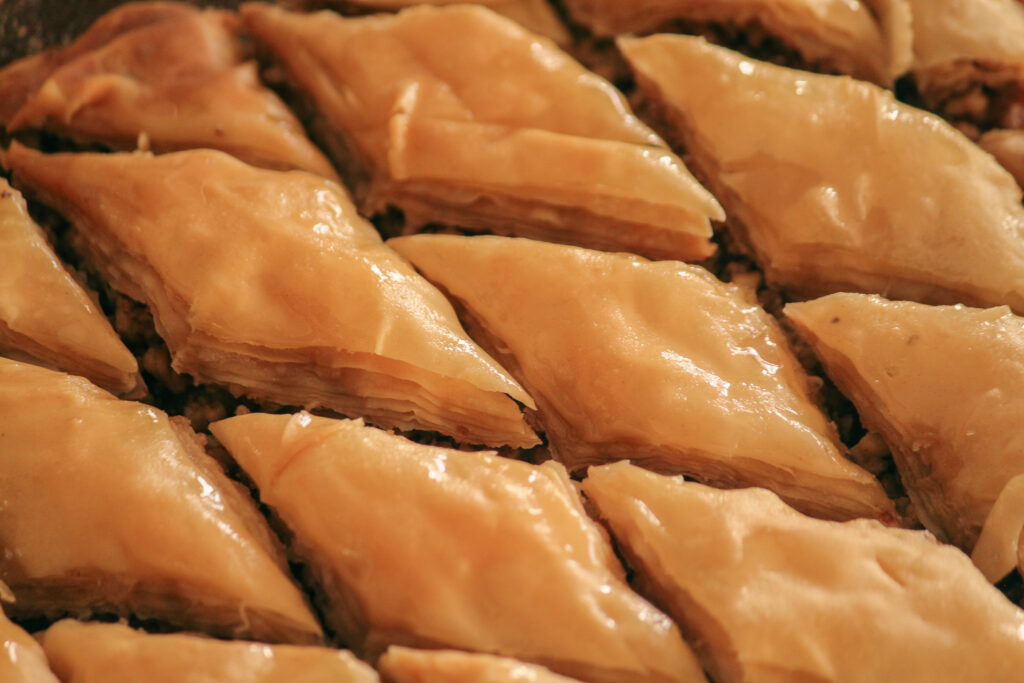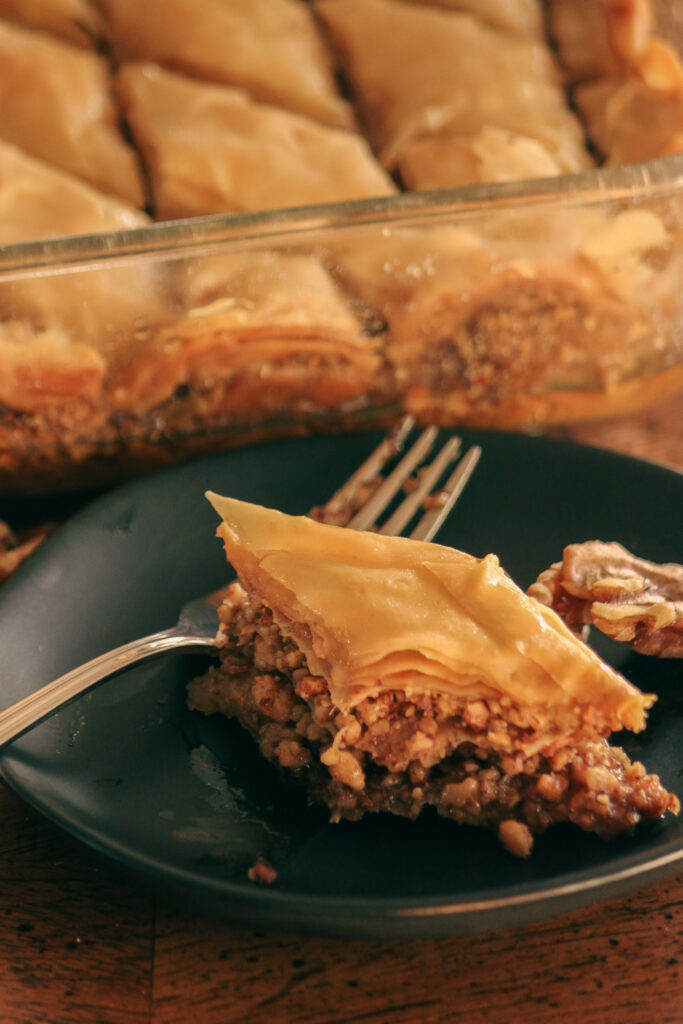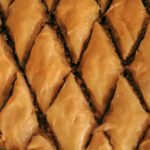
History
Baklava for St. Justinian is inspired by the cuisine of the ancient Byzantine Empire. Athenaeus of Naucratis lived just prior to Justinian and wrote a book that has survived to this day that records some of the culture and philosophy of eating during Justinian’s time. Athenaeus was a Greek and speaks to the Mediterranean diet that Justinian himself would have enjoyed, including these cakes of honey and nuts.
It is said that baklava, or at least a precursor to what is known today as baklava, was had just been introduced by the time Justinian was ruling. The chopped nuts combined with paper-thin dough layers and drenched in honey was likely a popular treat among many peoples, making the precise origins of baklava difficult to pin down. Nevertheless, it is a fitting and delicious treat to enjoy along with a cup of coffee while remembering the faith and good deeds of the Lord’s saint, Justinian.

Baklava
If you’ve never made baklava before, this tradition might seem a little intimidating—at least it did to us! But after trying our hand at making this crunchy, sweet, and nutty treat, it has quickly become a new favorite! In fact, it is a relatively simple yet impressive dessert. Baklava is made by assembling a pan of alternating layers of ingredients, baking, and pouring syrup over top. The dough comes pre-made at some grocery stores, or you can choose to make it by hand (we used this recipe). Whether you make the dough yourself or not, this video is a helpful visual for assembling the layers.
To achieve the perfect top pastry layers, it is important to brush butter over each and every layer of the last ten dough sheet. This isn’t crucial for the layers beneath the walnuts, but it is for the top layers as the butter will help the layers to flake nicely after baking and enhance the presentation and crunch.
Allow the baklava to cool completely before disturbing the pan, or you risk damaging some of the pieces.

Ingredients
1 package phyllo dough (or if homemade, we followed this recipe)
½ cup butter, melted and clarified
4 cups walnuts
2 tablespoon sugar
1 tablespoon cinnamon
Honey Syrup
1 cup water
½ cup sugar
½ cup honey
1 tsp vanilla
Instructions
- Defrost the phyllo dough according to the package instructions.
- Preheat the oven to 325°F.
- Melt the butter in the microwave and remove the foamy white layer on top to clarify the butter.
- Pulse the walnuts, cinnamon, and sugar together in a food processor and set aside.
- Assemble the baklava: first brush a layer of butter over the pan and place 10 layers of dough in the bottom of the pan. Brush the last dough sheet with butter and spread a layer of the nut mixture over top. Repeat this process two more times and then place the remaining dough layers (10) on top, buttering between every top dough sheet.
- Cut the baklava using a sharp knife by first cutting parallel lines across the pan, and then cut diagonally across those lines.
- Bake in the oven for two hours until the top layers are golden and crispy.
- While the baklava is baking, make the syrup by boiling the water and sugar for 5 minutes. Reduce to a simmer and add in the honey and vanilla until dissolved into the syrup. Allow to cool while the baklava finishes baking.
- As soon as you pull the baklava out of the oven, pour the syrup over it and allow it to cool before serving.

St. Justinian Baklava
Ingredients
- 1 package phyllo dough
- ½ C butter melted and clarified
- 4 C walnuts
- 2 tbs sugar
- 1 tbs cinnamon
Honey Syrup
- 1 C water
- ½ C sugar
- ½ C honey
- 1 tsp vanilla
Instructions
- Defrost the phyllo dough according to the package instructions.
- Preheat the oven to 325°F.
- Melt the butter in the microwave and remove the foamy white layer on top to clarify the butter.
- Pulse the walnuts, cinnamon, and sugar together in a food processor and set aside.
- Assemble the baklava: first brush a layer of butter over the pan and place 10 layers of dough in the bottom of the pan. Brush the last dough sheet with butter and spread a layer of the nut mixture over top. Repeat this process two more times and then place the remaining dough layers (10) on top, buttering between every top dough sheet.
- Cut the baklava using a sharp knife by first cutting parallel lines across the pan, and then cut diagonally across those lines.
- Bake in the oven for two hours until the top layers are golden and crispy.
- While the baklava is baking, make the syrup by boiling the water and sugar for 5 minutes. Reduce to a simmer and add in the honey and vanilla until dissolved into the syrup. Allow to cool while the baklava finishes baking.
- As soon as you pull the baklava out of the oven, pour the syrup over it and allow it to cool before serving.
References:
1. Athenaeus: The Deipnosophists. Book 14. http://www.attalus.org/old/athenaeus14c.html
2. Hale, William H. The Horizon Cookbook and Illustrated History of Eating and Drinking though the Ages, 1968.



That sounds like an amazing recipe. It might be a fun recipe to try for Christmas. Gods Blessings! ❤️
The Greek wife of a colleague sticks a clove into the top of each piece of baklava before baking; I had the opportunity to make it with her once. YUM!